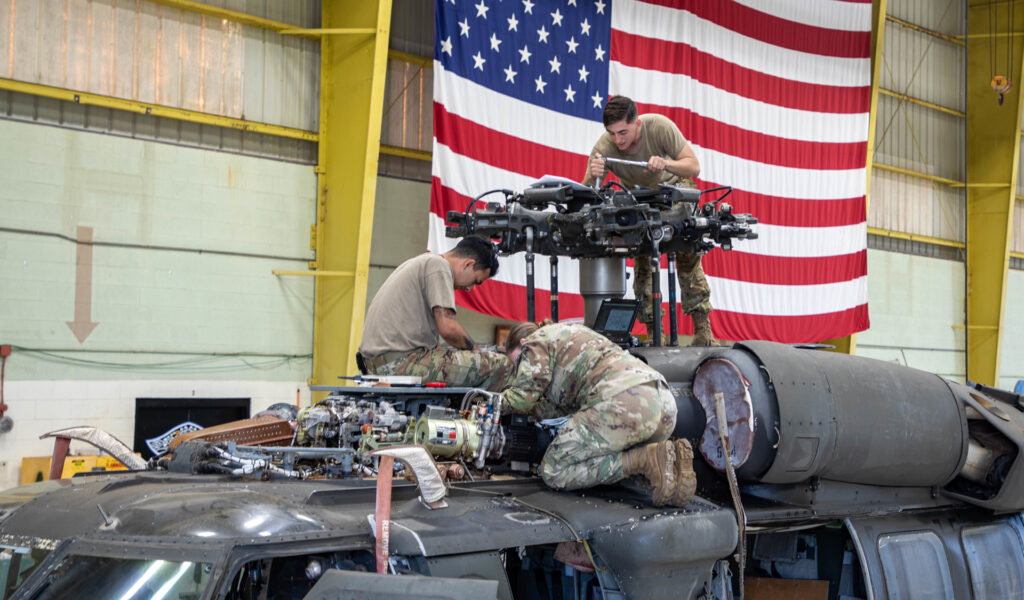
Lockheed Martin has demonstrated analytics-driven maintenance capabilities that are compatible with the Department of Defense’s 5G flight-line ecosystem. Pictured above, maintainers perform repairs on a UH-60 Black Hawk at Wheeler Army Airfield in Hawaii. (Photo: U.S. Army/Sgt. Sarah D. Sangster)
Data needed for analytics-driven aircraft maintenance can be rapidly and securely delivered to military personnel via 5G technology, leading to increased aircraft availability and lower maintenance costs, according to a Lockheed Martin executive involved in a recent proof-of-concept demonstration.
Following on a 2022 demonstration in which Lockheed Martin successfully transferred aircraft health and usage data from a Sikorsky UH-60 Black Hawk helicopter through an AT&T 5G private cellular network, the company said April 3 it has shown U.S. Army and Air Force officials that aircraft data can be utilized by multiple personnel using portable devices equipped with advanced-analytics capabilities.
The aircraft maintainers will have access to “intelligent troubleshooting applications” driven by artificial intelligence (AI) that will “minimize the maintenance burden on a variety of aircraft,” according to Lockheed.
The use of network-enabled analytics will provide military aircraft mechanics with more information “to arrive at the right conclusion [faster] about what’s happening with the maintenance of their aircraft,” Reeves Valentine, VP-land and maritime solutions at Lockheed Martin Rotary and Mission Systems, told Avionics International in an interview.
The demonstration, which took place in Hawaii, applied to data sets from both a UH60 and a Lockheed F-22, according to Valentine. Upon landing, an aircraft’s flight data is removed from the aircraft via traditional means and stored on a server, at which point the data is transferred over 5G to portable devices used by aircraft maintainers. The devices incorporate AI-driven predictive maintenance and sensor-data analytics.
This means maintenance personnel not only have access to data from the aircraft on which they are working, but also “access to databases about similar types of maintenance actions that have happened across the fleet,” Valentine said. “This can very quickly help inform the maintainer about which direction to go, what the proper maintenance action would be and how to do it without going in the wrong direction first.”
He added: “We really see this as a proof-of-concept of how aircraft availability can increase and costs can decrease because you’re streamlining that [data-transfer] process and putting relevant data at the fingertips of the maintainer on the flight line.”
The transfer speed is dramatically improved from the common process in which maintenance personnel remove a cartridge from the aircraft containing sensor data about its health, Valentine said, adding: ”That cartridge would have to be carried to the operations center, which has some transportation costs. Then you’re plugging it in and, as you start to get the data, you’re trying to determine, ‘What is the data telling me,’ and you don’t have the information about the rest of the fleet or trends or analytics or any of that. And you certainly don’t have an AI-machine learning tool that is learning off of massive amounts of data, curating likely outcomes of actions.”
He emphasized the technological capabilities being demonstrated are in the “early stages,” but added there are potentially widespread applications for analytics-driven predictive maintenance tools. Valentine noted that commercial aviation, with different communications security requirements, is already deploying such technology. “The technology is more mature in the commercial space,” he said. “It’s a matter of applying it within the military domain in a manner” compatible with stringent communications security requirements.
“The military is very interested in leveraging what’s happening in the commercial sector,” Valentine explained. “I think you can expand this far past aviation platforms to ground platforms, Navy surface and under surface operations, you name it. It’s really just connecting a broad swath of data and helping maintainers reach the right outcome with short lead times.”